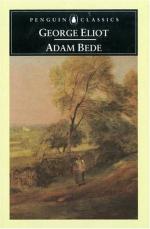|
This section contains 6,796 words (approx. 23 pages at 300 words per page) |

|
SOURCE: “Gyp's Tale: On Sympathy, Silence, and Realism in Adam Bede,” in Dickens Studies Annual, Vol. 20, 1991, pp. 227-42.
In the following essay, Adams examines the limits of the human ability to express emotion through language in Adam Bede.
In Chapter 21 of Adam Bede, the narrator remarks upon the quiet “drama” of three laborers learning to read: “It was almost as if three rough animals were making humble efforts to learn how they might become human” (281). Commentators on Eliot's novel frequently single out this evocation of an obscure struggle against mystery and dispossession: it has “unmistakably the quality of an allegorical panel,” as one critic remarks.1 But a tribute to the humanizing power of literacy is curiously discordant in a work which so strenuously insists on the inadequacies of formal education. Adam, after all, is not made any more human by his literacy: that hopeful view is gently parodied...
|
This section contains 6,796 words (approx. 23 pages at 300 words per page) |

|


